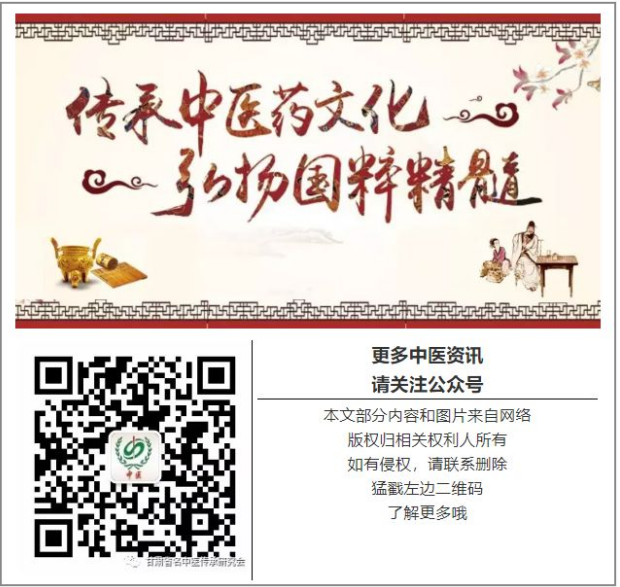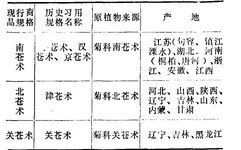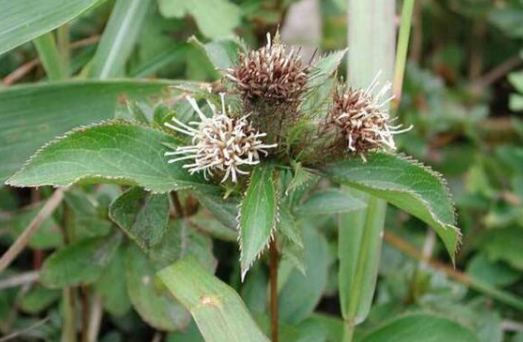
Atractylodes is primarily used for conditions of Qi deficiency and excessive dampness or phlegm, and can treat symptoms such as decreased appetite and loose stools. Atractylodes is a medicinal herb that has the properties of promoting Qi, relieving pain, strengthening the spleen, and eliminating dampness. Traditional Chinese Medicine (TCM) considers its nature to be slightly warm, with a bitter and pungent taste, mainly used for diseases related to spleen deficiency and excessive dampness or phlegm.
【Source】This product is the dried rhizome of the Asteraceae plant Atractylodes lancea (Thunb.) DC. or Atractylodes chinensis (DC.) Koidz. Harvested in spring and autumn, cleaned of soil, dried, and the fibrous roots removed.
【Origin】
1. Atractylodes chinensis: Mainly produced in Hebei, Shanxi, Inner Mongolia, and Shaanxi provinces. Additionally, it is distributed in Shandong, Henan, Gansu, Liaoning, and Jilin. It is sold nationwide and exported. Atractylodes chinensis is primarily produced in the three northeastern provinces and sold in northern provinces. The Atractylodes produced in Hebei is often distributed in Tianjin, hence the name “Tianjin Atractylodes”.
2. Atractylodes lancea: Mainly produced in Jurong, Zhenjiang, and Lishui in Jiangsu, as well as in Xiangyang and Nanzhang in Hubei, and Tongbai and Tanghe in Henan. Additionally, it is found in Zhejiang, Anhui, and Jiangxi. The best quality comes from the Maoshan area in Jiangsu, hence referred to as “Maoshan Atractylodes” or “Maoshan Atractylodes”, while those distributed in Nanjing are also called “Jing Atractylodes” or “Jing Atractylodes”. The Atractylodes from Hubei and Jiangxi is mostly distributed in Hankou, hence also called “Hankou Atractylodes”.
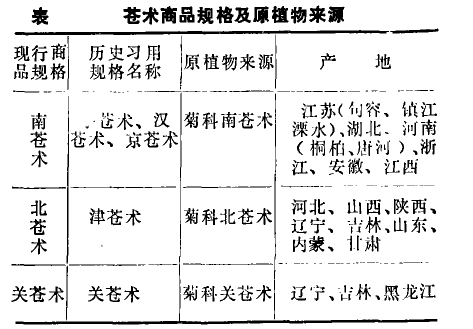
【Alias】Chi Atractylodes (陶弘景), Ma Jizhi (《说文系传》), Qing Atractylodes (张衮《水南翰记》), Xian Atractylodes (《纲目》), Qiangtou Cai.
【Plant Morphology】
① Atractylodes lancea
Perennial herb, 30-80 cm tall. The rhizome is large and irregular. The stem is single, round with longitudinal ridges, slightly branched at the top. Leaves are alternate, leathery and thick; the lower leaves are mostly 3-lobed, with the lobes pointed, the largest lobe being ovate and the base wedge-shaped, without petioles and slightly clasping the stem; the upper leaves are ovate-lanceolate to elliptical, about 4 cm long and 1-1.5 cm wide, without petioles, with spiny serrations along the edges. The upper surface is dark green, while the underside is slightly white powdery. The head-like flower clusters are terminal, about 2 cm in diameter; the involucre is leaf-like with many spiny bracts; the involucral bracts are 6-8 layers, lanceolate, membranous, green on the back, with purple edges and long hairs; the receptacle is flat, with many flowers, both bisexual and unisexual flowers often on different plants; the bisexual flowers have many feathery long crown hairs; the corolla is tubular, white, sometimes slightly reddish-purple, with 5 lobes at the tip, the lobes being linear; the stamens are separate; the ovary is inferior, long cylindrical, densely covered with white soft hairs, the style is long, and the stigma is bifid. The unisexual flowers are generally female, with 5 linear degenerate stamens, completely separate, slightly curved at the tip, while the rest is similar to the bisexual flowers. The achene is elongated, about 5 mm long, covered with brownish-yellow soft hairs. The flowering period is from August to October. The fruiting period is from September to October.
It often grows in drier areas on hillsides. Distributed in Jiangsu, Zhejiang, Anhui, Jiangxi, Hubei, Hebei, Shandong, etc.
② Atractylodes chinensis, also known as: Mountain Atractylodes, Qiangtou Cai, Mountain Thorn Vegetable.
Perennial herb, 30-50 cm tall. The rhizome is large and tuberous. Leaves are petiole-less; the lower leaves are spoon-shaped, mostly 3-5 deeply lobed, with blunt tips and wedge-shaped bases slightly clasping the stem; the upper leaves are ovate-lanceolate to elliptical, 3-5 shallowly lobed to entire, with hard serrated edges. The head-like flower clusters are about 1 cm in diameter; the basal leaf-like bracts are lanceolate with long serrated edges; the involucral bracts are mostly 5-6 layers; the corolla is tubular, white, with 5 lobes at the tip, the lobes being long-ovate; the degenerate stamens have rounded tips and are not curled. The achene is densely covered with upward-facing silver-white hairs. The flowering period is from July to August. The fruiting period is from August to October.
It grows in shrub thickets on hillsides and drier areas. Distributed in Jilin, Liaoning, Hebei, Shandong, Shanxi, Shaanxi, Inner Mongolia, etc.
【Harvesting and Processing】 After 2-3 years of cultivation, the rhizomes are dug up from early September to early November or in February-March of the following year, removing residual stems, shaking off the soil, drying, and removing the fibrous roots or burning them off after drying to about 90% dry, then drying completely.
【Characteristics】
Atractylodes lancea: Irregularly bead-like or tuberous cylindrical shape, slightly curved, occasionally branched, 3-10 cm long, 1-2 cm in diameter. The surface is gray-brown, with wrinkles, transverse grooves, and residual fibrous roots, with a stem scar or residual stem base at the top. The texture is solid, the cross-section is yellow-white or gray-white, with many orange-yellow or reddish-brown oil chambers, which can produce white needle-like crystals if exposed for a while. The aroma is distinctive, with a slightly sweet, pungent, and bitter taste.
Atractylodes chinensis: Mountain Atractylodes, Qiangtou Cai, Mountain Thorn Vegetable. It is often in a lump-like or tuberous cylindrical shape, 4-9 cm long, 1-4 cm in diameter. The surface is black-brown, and the inner color is yellow-brown after removing the outer skin. The texture is relatively loose, with a cross-section showing yellow-brown oil chambers. The aroma is milder, with a pungent and bitter taste.
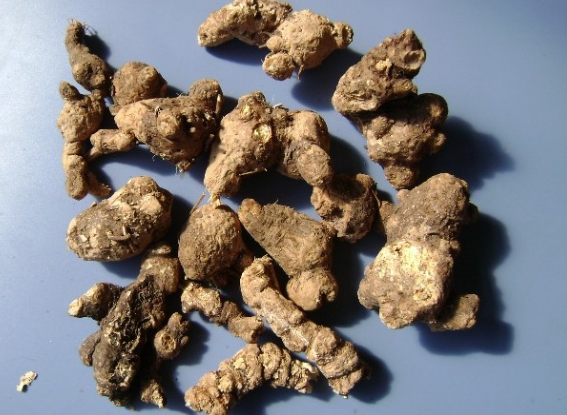
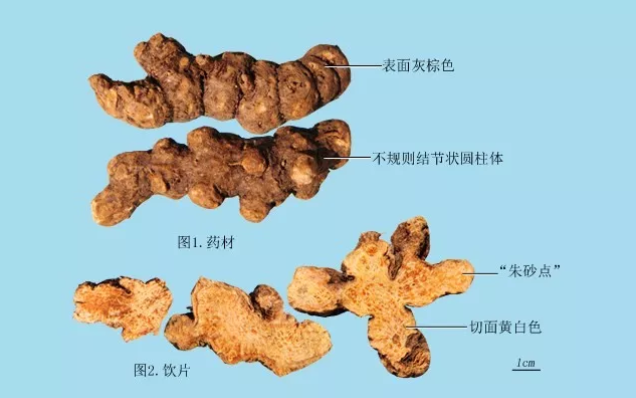
【Commercial Source and Experience Identification】There are about 8 species of Atractylodes in China, most of which are produced in North China and Northeast China. The main species in Northeast China is Atractylodes chinensis, followed by Atractylodes lancea. There are also small amounts of Korean Atractylodes in Liaoning and Jilin, which are also used medicinally, with similar external morphology and tissue characteristics to Atractylodes chinensis.
The commercial specifications of Atractylodes have historically been based on the production area and sales distribution, usually divided into Atractylodes chinensis, Atractylodes lancea, and Atractylodes from Tianjin and Beijing.
Atractylodes chinensis is produced in Northeast Liaoning, Gai County, Haicheng, and Liaoyang. It is mainly sold in East China and northern regions, with relatively high quality.
Atractylodes from Hubei is mostly concentrated in Hankou, mainly sold in the Yangtze River basin, Hunan, Hubei, Guangdong, and for export.
Atractylodes lancea is mainly produced in Jurong, Jiangsu, and is primarily sold in East China, with the best quality and most fame.
Atractylodes from Beijing has the same origin as Atractylodes lancea, named for its distribution in Nanjing.
Atractylodes from Tianjin is produced in various places in Hebei, mostly distributed in Tianjin, and also referred to as Atractylodes from Henan.
Currently, commercial Atractylodes is mainly divided into Atractylodes lancea, Atractylodes chinensis, and Atractylodes from Guanshan.
Experience identification characteristics:
1. Atractylodes lancea: The rhizome is mostly bead-like cylindrical, 1-2 cm in diameter, slightly curved. Gray-brown to gray-brown, with longitudinal wrinkles, transverse grooves, and residual fibrous roots. The texture is solid, with a cross-section showing yellow-white color, with yellow oil spots scattered (commonly known as “朱砂点”). The aroma is distinctive, with a slightly sweet, pungent, and bitter taste.
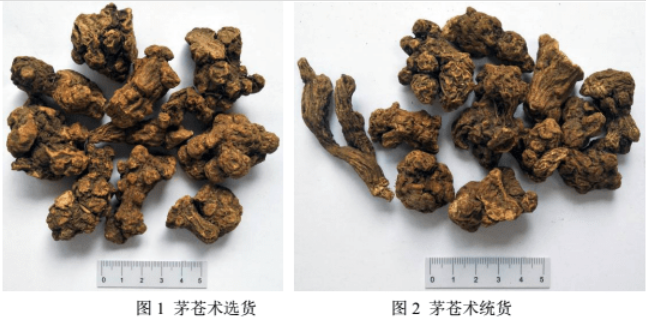
2. Atractylodes chinensis: The rhizome is mostly lump-like or tuberous, 1-4 cm in diameter, relatively short and thick, black-brown, and yellow-brown after removing the outer skin. The texture is relatively loose, with a fibrous cross-section. The aroma is weaker, with a slightly bitter and pungent taste.
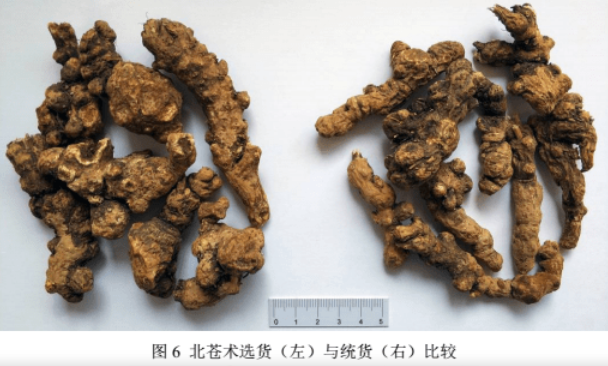
3. Atractylodes chinensis: The rhizome is mostly knot-like cylindrical, longer, with a distinctive aroma and a slightly pungent and bitter taste.
【Counterfeit and Confusable Products】Utilizing the characteristics of medicinal materials for identification and microscopic identification methods to find differences between Atractylodes and its counterfeit products in terms of oil chambers and fibrous characteristics, and then using high-performance liquid chromatography to determine the content of Atractylodes. The results show that the oil chambers of Atractylodes are dark and obvious, with a strong aroma, weak fibrous characteristics, and contain Atractylodes; while the counterfeit products Atractylodes chinensis and Korean Atractylodes have light and indistinct oil chambers, weak aroma, strong fibrous characteristics, and do not contain or contain trace amounts of Atractylodes. The conclusion is that the components and aroma of counterfeit Atractylodes are significantly different from those of genuine Atractylodes, and they cannot replace Atractylodes for medicinal use.
Atractylodes chinensis: The rhizome is mostly irregularly lump-like or tuberous, cylindrical, with one end exposing fibrous-like fibers. It is 4-12 cm long and 1-2.5 cm in diameter. The surface is dark brown, with root scars and small fibrous roots, and residual stem scars. It is relatively light, with a loose texture, and the cross-section is unevenly yellow-white, often fibrous, with occasionally scattered indistinct light yellow oil chambers. It has a strong distinctive aroma, with a pungent and slightly bitter taste.
Korean Atractylodes: Similar in appearance to Atractylodes chinensis, slightly fibrous, with a cross-section showing net-like cracks or small cavities, without reddish-brown oil chambers, with a distinctive aroma, and a slightly pungent and bitter taste.
【Specifications and Grades】The “Specifications and Grades for Atractylodes” is an industry standard implemented on December 3, 2018.
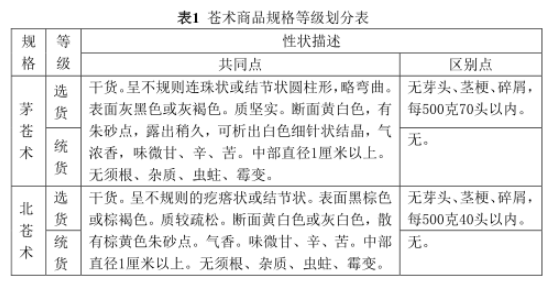
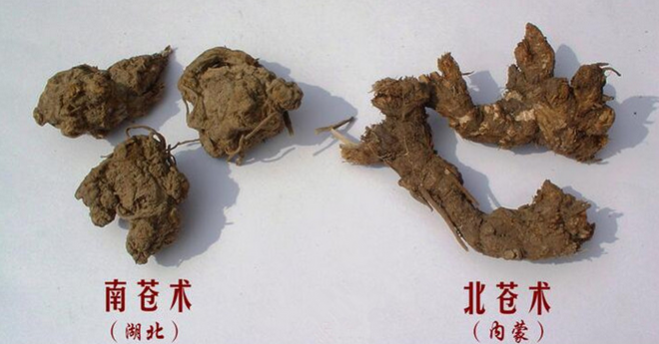
【Processing】
Pharmacopoeia: 1. Atractylodes: Remove impurities, wash clean, soak until slightly translucent, cut into thick slices, and dry.
2. Fried Atractylodes: Take Atractylodes slices, fry according to the method (Appendix II D) until the surface is deep yellow. This product appears as round or thick slices, with gray debris not exceeding 3% (Appendix IX B).
Other processed products: Fried Atractylodes, honey-fried Atractylodes, earth-fried Atractylodes, rice wash Atractylodes, charred Atractylodes, Atractylodes charcoal, and salt Atractylodes.
1. Atractylodes: Remove impurities, soak in water until 70-80% translucent, take out, soak until fully permeated, cut into slices, and dry.
2. Fried Atractylodes: Take Atractylodes slices, moisten with rice wash water, and fry in a pot over low heat until slightly yellow; or take cleaned Atractylodes, soak in rice wash water, take out, steam until fully cooked, cut into slices, and dry.
3. Charred: Take Atractylodes slices, fry over high heat until the surface is charred black, the inside is dry yellow, and then take out; dry.
4. Salted: Take Atractylodes, fry over high heat until the outer skin is charred black, add salt water, fry dry, and take out. For every pound of Atractylodes, add 5 qian of salt and an appropriate amount of water.
5. Atractylodes is dry in nature, so it is soaked in glutinous rice wash to remove its oil, cut into slices, and dried, or fried with sesame oil to reduce its dryness.
【Chemical Components】
The rhizome of Atractylodes lancea contains about 5-9% volatile oil. The main components of the oil are Atractylon, Atractylodes alcohol, and β-eucalyptol.
The rhizome of Atractylodes chinensis contains 1.5% volatile oil, with the main components being Atractylon, Atractylodes ketone, Atractylodes alcohol, and eucalyptol.
【Pharmacological Effects】
(1) Adjusting gastrointestinal motility: Atractylodes decoction and Atractylodes alcohol extract can significantly relieve acetylcholine-induced intestinal spasms in rabbits within a certain dosage range, and have a certain antagonistic effect on adrenaline-induced intestinal motility inhibition.
(2) Anti-ulcer: Atractylodes has a strong anti-ulcer effect. ① Inhibits gastric acid secretion ② Enhances gastric mucosal protective effect.
(3) Hepatoprotective: Atractylodes, β-eucalyptol, Atractylodes alcohol, and Atractylodes ketone have significant preventive effects on liver cell damage induced by CCL4 and D-galactosamine.
(4) Antibacterial: Atractylodes extract has the effect of eliminating the resistant plasmid of Shigella flexneri, which can reduce the generation of bacterial resistance.
【Quality Evaluation】The medicinal material is best when it is solid, with a cross-section showing many red mercury spots and a strong aroma.
【Taste and Meridian Entry】Pungent, bitter, warm. Enters the spleen, stomach, and liver meridians.
【Functions and Indications】Strengthens the spleen, dries dampness, relieves depression, and dispels filth. Treats excessive dampness obstructing the spleen, fatigue, lethargy, abdominal distension, loss of appetite, vomiting, diarrhea, dysentery, malaria, phlegm-dampness, edema, seasonal colds, wind-cold-damp bi syndrome, foot weakness, and night blindness.
【Dosage and Administration】Pharmacopoeia: 3-9 g. Chinese Materia Medica: For internal use: decoction, 3-9 g; or in pills or powders. Chinese Herbal Dictionary: For internal use: decoction, 1.5-3 qian; or in syrup or pills.
【Storage Conditions】Store in a cool, dry place.
【Clinical Applications】
As an important herb for dispelling dampness, it is applicable for both internal and external dampness. Historical experience states: “Atractylodes is most effective for treating external dampness.”
1. Used for treating indigestion (commonly referred to as dampness obstructing the middle burner), with symptoms of fullness and discomfort in the stomach, loss of appetite, or vomiting or diarrhea, often combined with Hou Po and Chen Pi, as in the Ping Wei San formula; if there is a tendency towards heat stagnation, it can also be combined with Xiang Fu, Shen Qu, and Zhi Mu.
2. Used for treating diarrhea, especially summer diarrhea with heavy damp-heat, often combined with Yin Hua and Fu Ling.
3. Used for treating rheumatism, especially muscular rheumatism. Often combined with Ma Huang, Gui Zhi, and Yi Yi Ren to enhance analgesic effects. If there is heat bi with fever, thirst, and severe joint pain with redness and swelling, it can be combined with Shi Gao to clear heat, as in the Bai Hu Jia Cang Zhu Tang formula.
4. Used in surgery, with certain effects for treating jaundice and perianal tuberculosis. It can also treat lower limb abdominal distension and pain due to damp-heat, resembling erysipelas, often combined with Huang Bai, Niu Xi, and Sheng Yi Ren, as in the Si Miao Wan formula.
5. Used in ophthalmology for treating night blindness and corneal softening after measles, taking advantage of its vitamin A content, often used in pills or powders (there are reports of effective decoction). It can be used alone in powdered form or combined with Mu Zei. Prescription: Atractylodes 120 g, Mu Zei 60 g, ground into powder and mixed; taken with vegetables 3-6 g at meal times, or combined with ram liver.
Additionally, it can be used for strengthening. Treats mental fatigue, weakness of limbs, especially in cases of deficiency and cold, often combined with Shu Di and Gan Jiang.
Usage precautions: Atractylodes is relatively pungent and dry, so it is not suitable for those with yin deficiency and blood dryness, or those with hemoptysis and epistaxis.
Note: Both Atractylodes and Hou Po can transform dampness. When treating fullness and vomiting in the gastrointestinal tract, they are often used together, but Atractylodes is stronger in dispelling wind and drying dampness; for warming the middle and relieving fullness, Atractylodes is not as effective as Hou Po.
Dosage: 3-9 g.
Example prescriptions: 1. Ping Wei San (《局方》): Atractylodes 9 g, Hou Po 6 g, Chen Pi 6 g, Gan Cao 3 g, decocted in water for oral administration.
2. Bai Hu Jia Cang Zhu Tang: Atractylodes 9 g, Sheng Shi Gao 30 g (crushed and decocted first), Zhi Mu 12 g, Gan Cao 6 g, Sang Zhi 12 g, Fang Ji 9 g, Yin Hua Teng 9 g, decocted in water for oral administration.
3. Si Miao Wan (《丹溪心法》): Atractylodes, Huang Bai, Niu Xi, Sheng Yi Ren, all equal parts ground into powder, made into pills, taken 6-9 g with warm water.
【Precautions】
1. This product is pungent, warm, and dry, so it is contraindicated for those with yin deficiency, internal heat, or excessive sweating.
2. According to the “Bencao Jing Jizhu”: Fang Feng and Di Yu are used as assistants.
3. According to the “Yao Xing Lun”: Avoid peaches, plums, sparrow meat, mustard greens, and blue fish.
4. According to the “Yixue Rumen”: Those with blood deficiency and weakness, as well as those with emotional distress and qi stagnation should use with caution. Misuse can deplete qi and blood, dry body fluids, and exacerbate fullness and discomfort.
5. According to the “Bencao Jing Shu”: For conditions of yin deficiency, blood deficiency, insufficient essence, internal heat, bone steaming, dry mouth and lips, coughing with phlegm, hemoptysis, epistaxis, throat obstruction, and constipation, it is advised to avoid.
6. According to the “Bencao Zheng”: For internal heat and yin deficiency, and those with spontaneous sweating, it is contraindicated.
The organization, collection, and editing of the article and images are sourced from the internet.Note: The various prescriptions and formulas mentioned in this article are for reference and study by professional TCM practitioners only and should not be used as prescriptions. Please do not use them blindly; this platform does not bear any responsibility for any consequences arising from this.
